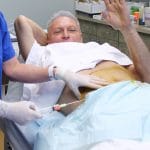Fat transfers (also known as microfat transfers and fat grafts) have been used for years to restore youthful facial proportions, enhance features, augment curves, and correct deformities. Fat is rich in stem cells and growth factors so it also improves the quality of the overlying skin. Results from fat grafting can last up to ten years.
What’s involved in a fat transfer treatment?
 People interested in having a fat grafting treatment need to have a consultation to determine if a fat transfer is their best treatment option. Smokers, patients on anticoagulants (blood thinners), people with poorly controlled medical problems, those whose weights fluctuate up and down more than 10 lbs, and people who have body dysmorphic disorder, are not eligible for the treatment.
People interested in having a fat grafting treatment need to have a consultation to determine if a fat transfer is their best treatment option. Smokers, patients on anticoagulants (blood thinners), people with poorly controlled medical problems, those whose weights fluctuate up and down more than 10 lbs, and people who have body dysmorphic disorder, are not eligible for the treatment.
Since only a relatively small amount of fat is needed for transfers, the treatment does not produce body contouring results like that seen with liposuction of larger quantities. The fat used for grafting is most often obtained from areas where fat is most resistant to weight loss, such as the abdomen or flanks. Resistant fat is theoretically able to persist the best in the areas to which it’s transferred.
On the day of the treatment, Dr. Elliott gently injects anesthetic and then painlessly removes a small amount of fat through one or two needle puncture sites. The fat is washed free of anesthetic and blood and then meticulously injected into the areas where added volume is desired.
No stitches are needed but the area where the fat was harvested is usually tender and feels bruised for a few days after the procedure. Facial bruising and swelling in the areas where the fat is transferred can vary from none to moderate, varying of course among individuals.
What are potential problems or complications with fat transfer?
Every patient reacts differently and the results of fat transfers are less predictable than with dermal fillers. A general rule is that the amount of improvement that’s still present three months after the treatment will likely last up to ten years, but it’s possible no improvement will remain by three months. People interested in fat transfer treatments must accept that they may need to repeat the treatment to get their desired result.
Like any procedure utilizing injections, expected side effects can include bleeding and bruising at the harvesting or injecting sites. Rarely, depressions at the site where the fat is harvested may result. As with dermal fillers, over-correction and under-correction at the site where the fat was transferred can occur and as with fillers, there is a very slight risk of accidental injection into an artery, which can cause catastrophic complications including tissue loss and scarring, stroke, blindness, or death. Post-treatment infections, especially with large liposuction treatments are possible.
The duration of volumizing results from a fat transfer is more unpredictable than the results seen with dermal fillers, so if a patient doesn’t need a lot of volume replacement, they may be happier with the results of dermal fillers. Some people maintain the volume that the fat restored for over ten years and some people lose all of their improvement in less than three months. It’s impossible to predict who will get the best results with fat grafting, so patients not willing to do a touch-up fat transfer procedure if needed, should probably choose a different treatment option.
Fat transfer fees start at $1,900 and are based on the amount of fat transferred.
Call our office at 727-571-1923 today or click here to make an appointment for a complimentary initial consultation, to learn if a fat treatment is your best option.






